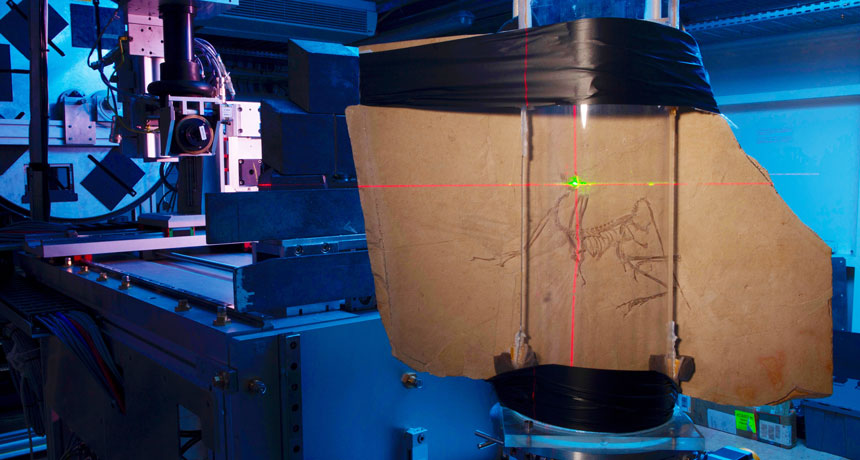
ANALYZING ARCHAEOPTERYX Researchers mounted the block of limestone with the Archaeopteryx fossil known as “The Munich Specimen” to analyze its wing bones. The examination suggests the ancient dino-bird flapped its wings while flying.
Pascal Goetgheluck/ESRF
- More than 2 years ago
Archaeopteryx was a flapper, not just a glider. The shape of the ancient bird’s wing bones suggests it was capable of short bursts of active, flapping flight, similar to how modern birds like pheasants and quails fly to escape predators, a new study finds.
One of the earliest birds, Archaeopteryx lived about 150 million years ago during the Jurassic Period, spanning the evolutionary gap between modern birds and feathered dinosaurs. Fossils of the primitive fowl have been instrumental in the recognition that birds are dinosaurs (SN Online: 7/31/14). But researchers have long wrangled over how well these ancient dino-birds could fly.
Archaeopteryx doesn’t have several features considered essential to flight in modern birds, such as a keeled breastbone to which several important flight muscles attach; a ball-and-socket arrangement that allows the wing to flap fully up over the back and down again; and a muscle pulley system that links chest and shoulder muscles, allowing the birds to swiftly alternate between powerful downstrokes and upstrokes. Previous researchers also have suggested that Archaeopteryx’s plumage was too delicate and might have snapped with vigorous flapping (SN: 6/5/10, p. 12). Based on these observations, the primitive bird was thought to merely glide from branch to branch, rather than flapping its wings to fly.
Paleontologist Dennis Voeten and colleagues decided to look for other features that might indicate the dino-birds flapped their wings while flying. The researchers used X-ray microtomography to examine two different wing bones — the humerus, or upper arm bone, and a lower arm bone called the ulna — in three Archaeopteryx fossils.
The team compared the thickness of the bones’ walls and their resistance to torsion — a twisting force that birds’ wings withstand during flapping flight — with similar bones from several dinosaurs, flying reptiles called pterosaurs and modern birds. Archaeopteryx had wing bone structures most similar to pheasants and quails, birds that are capable of small bursts of active flapping flight, the researchers report March 13 in Nature Communications.
In examining the shape of the wing bones, the study takes a novel approach to the question of whether Archaeopteryx could fly, says ornithologist Gerald Mayr of the Senckenberg Research Institute Frankfurt, who was not involved in the research.
But the study doesn’t answer whether Archaeopteryx could launch itself from the ground into the air. “Their results convincingly show that it could do active flight” once it was already airborne, Mayr says. “What they do not explain is how it would have been possible to produce strong flapping flight to take off from the ground.” Other early birds might have used a combination of wing and leg strength to launch into the air, but this hasn’t been shown for Archaeopteryx (SN: 11/26/16, p. 9).
To understand whether and how Achaeopteryx actually flew, researchers would need to reconstruct the animal’s full range of motion — a challenging prospect given that muscles don’t fossilize, says Voeten, of Palacký University Olomouc in the Czech Republic.
The primitive birds, without flight adaptations such as the muscle pulley system, wouldn’t have been capable of the full range of flapping motion birds today use. Instead, other parts of its anatomy indicate Archaeopteryx may have thrown its wings upward and forward, similar to a swimmer’s butterfly stroke, Voeten says. “Dedicated studies would need to show if it would work that way.”






